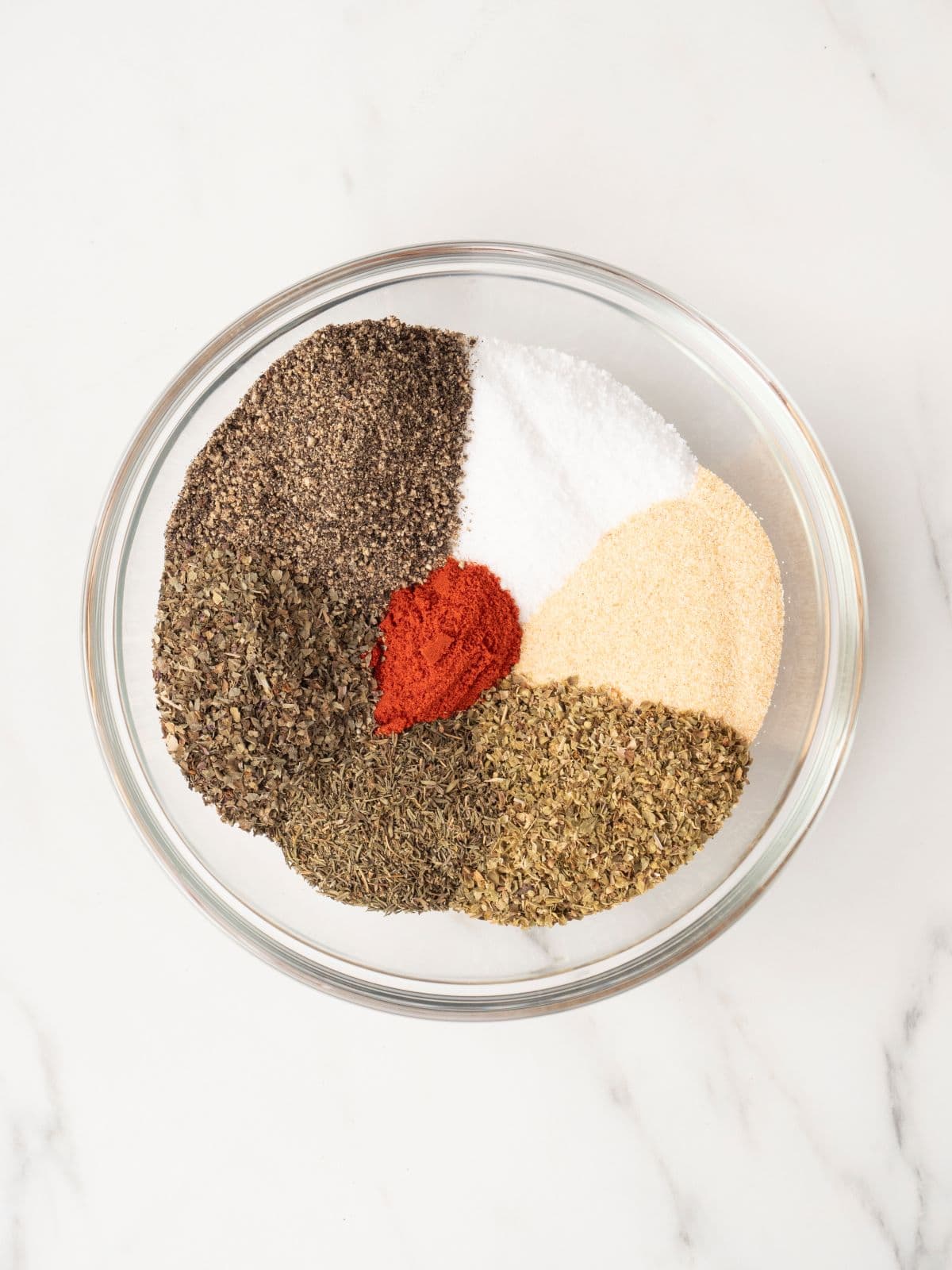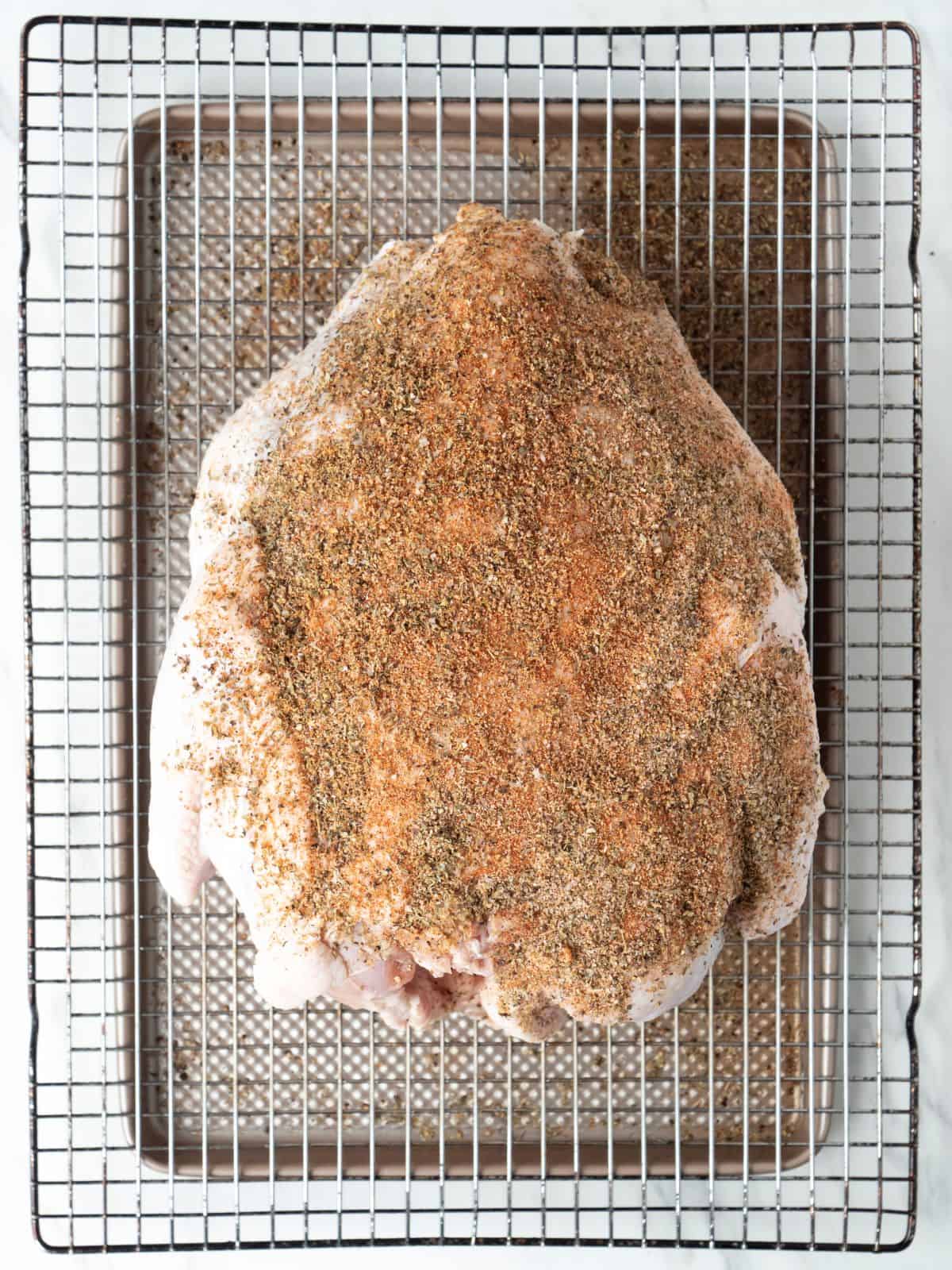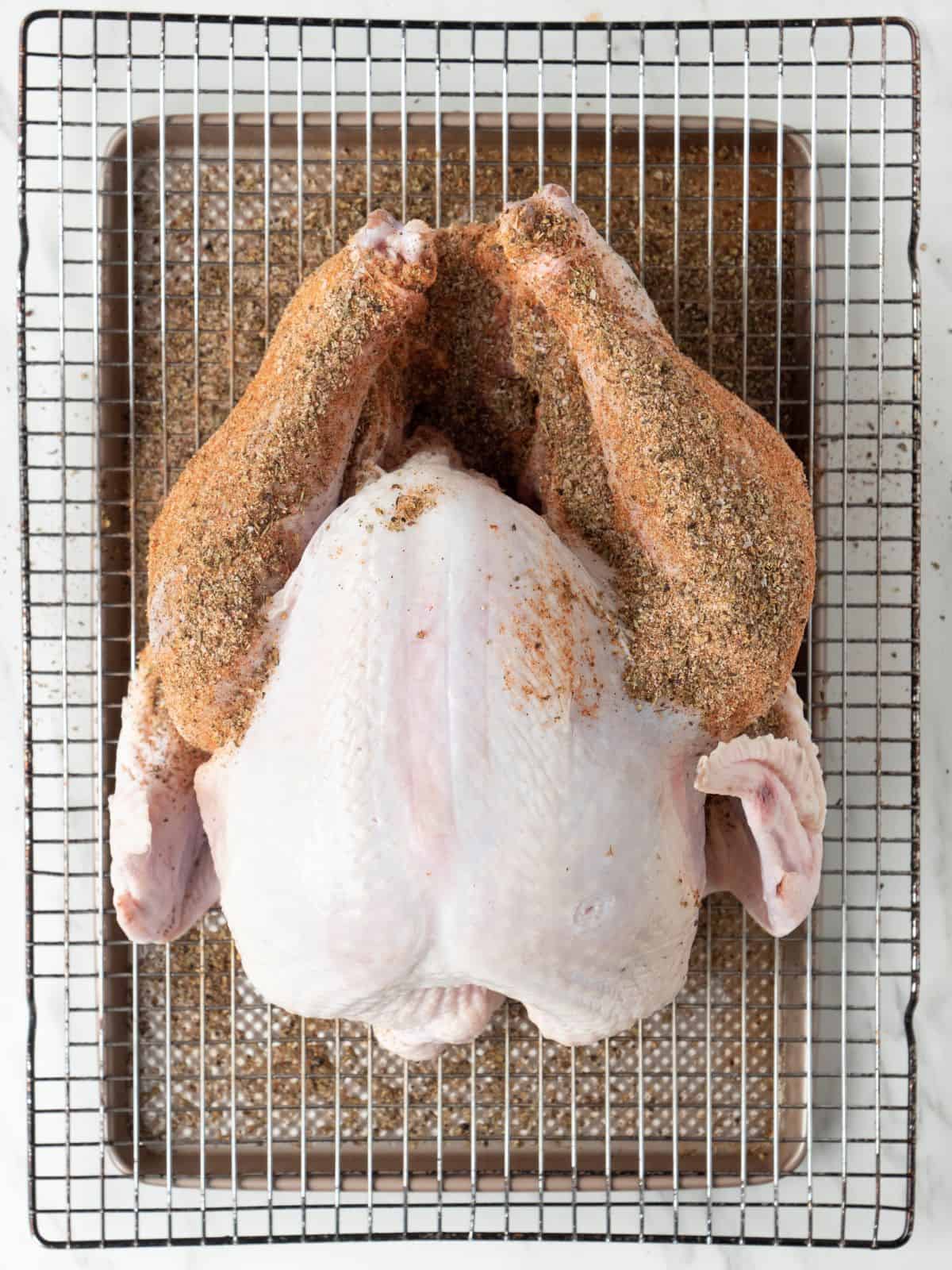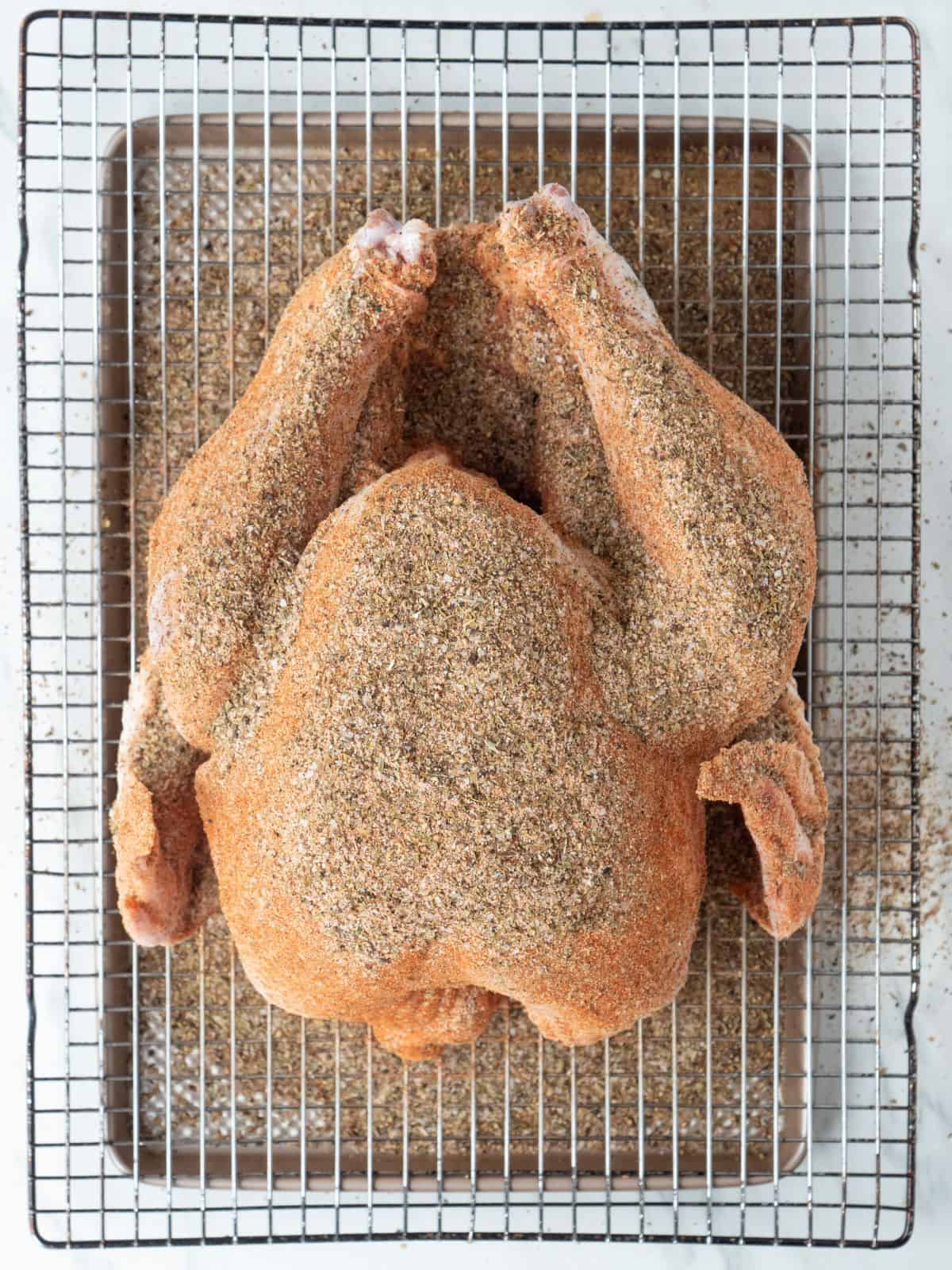If youre looking for an easy way to add flavor and moisture to your Thanksgiving turkey, look no further than this easy turkey brine recipe. There are two options: a dry brine and a wet brine. Both methods are simple and produce delicious results. So choose the option that fits your schedule and get ready to enjoy a juicy, flavorful turkey on Thanksgiving Day!
Brining a turkey, whether using a wet or dry method, is a great way to ensure a moist, flavorful bird on your holiday table. But can you actually brine a turkey using both techniques? Let’s dive into the details on wet brining, dry brining, and whether it’s possible (and a good idea) to combine both methods.
Brining, simply put is soaking meat in a saltwater solution (wet brine) or rubbing it with salt (dry brine) before cooking. This process helps flavor and tenderize the meat while also retaining moisture.
For turkeys specifically brining leads to a juicier interior and crisper skin when roasted. A wet brine achieves this by soaking the bird in a saltwater bath so the brine can directly penetrate the meat. A dry brine works by drawing moisture out of the turkey initially then allowing it to absorb back in along with the salty seasoning.
Both techniques produce delicious results, so which is better – wet or dry? The choice often comes down to personal preference, space constraints, and how far in advance you can brine.
Wet Brining a Turkey
How it works: The turkey is fully submerged in a saltwater solution for 12-24 hours. The salt in the brine penetrates deep into the meat for enhanced moisture and flavor.
Benefits:
- Quickly infuses flavor and moisture into the entire bird.
- Allows you to add other seasonings into the brine.
- Minimum hands-on time compared to dry brining.
Drawbacks:
- Requires lots of fridge/cooler space for a large container.
- Can result in soggy skin if not properly dried afterward.
- Adds more moisture to the skin, which may inhibit browning.
Tips for success:
- Use kosher salt and maintain a ratio of 1 cup salt to 1 gallon water.
- Submerge the turkey completely and weigh it down if needed.
- Chill the brine with ice water, never use warm liquid.
- Thoroughly pat dry and air-dry the turkey after brining.
Dry Brining a Turkey
How it works: Salt is rubbed directly onto the meat and allowed to penetrate over 24-48 hours. The salt initially draws out moisture then allows it to reabsorb.
Benefits:
- Takes up very little fridge space.
- Produces crispier skin as moisture gets drawn out.
- Infuses salt evenly into meat.
- Allows seasoning under the skin.
Drawbacks:
- Can take more active time to rub the salt thoroughly over and under the skin.
- Slower infusion of moisture compared to wet brine.
- Skin may end up excessively salty if too much salt is used.
Tips for success:
- Gently loosen the skin from the meat before rubbing the salt.
- Use 1 tablespoon kosher salt per 4 pounds of turkey.
- Sprinkle salt inside cavity as well as over and under skin.
- Leave uncovered in the fridge for 6-12 hours before cooking for ultimate crisping.
Is It Possible to Combine Wet and Dry Brining?
Theoretically, you could wet brine a turkey first, then pat it dry and follow up with a dry brine for enhanced flavor and crisping. However, it is generally not recommended.
Here’s why:
- Overbrining leads to an overly salty bird. The wet brine alone sufficiently penetrates and seasons the meat.
- Going from wet to dry risks uneven moisture levels in the meat.
- It overly complicates the process without much added benefit.
For best results, choose either a straightforward wet or dry brine and avoid combining both on the same turkey.execute
Choosing Between Wet and Dry Brining
When deciding between wet and dry brining methods, keep these factors in mind:
- If short on time, wet brining works faster.
- If space is limited, dry brining is more compact.
- Dry brining achieves crisper skin.
- Wet brining offers flexibility to add other flavors.
- Dry brining requires more active prep time.
You can’t go wrong with either technique – both wet and dry brining lead to a juicier, more flavorful turkey than no brining at all. Test out different methods each year to find your personal favorite approach to deliciously brined, roast turkey perfection.

How to Brine a Turkey

Step 1: Combine all the seasonings together. Set a wire cooling rack on a baking sheet and place the turkey on the rack.

Step 2: Rub ½ cup of the dry brine on the back side of the turkey

Step 3: Rub ½ cup on the legs and 1 cup on the breast.

Step 4: Transfer the turkey, uncovered to the fridge and refrigerate for at least 24 hours, and up to 72 hours.
During the brining process, you soak the turkey in a salt and water mixture (with other aromatics if you want to get jazzy) and the turkey absorbs that extra moisture from the liquid. (note: youll need a large vessel to store the turkey and liquid in) This process helps it stay moist and juicy during cooking! Which then means its still moist and juicy once you carve it and serve.
Brining also helps season the turkey from the inside out so no matter what piece you get, itll be delicious! If you don’t have room for the large vessel as mentioned above, a dry brine is the easier way to go.
What kind of bird should you use for this turkey brine recipe?
This is super important!! You basically just want a plain old turkey. Dont get one with any other “enhanced” or “self-basting” descriptors on the package. Those mean that the turkey has already been brined or treated and Id rather do it myself so I have full control over what is going into my bird and brine.
Dry Brined Turkey on a Pellet Grill
FAQ
Can I wet brine and dry brine a turkey?
Can you brine and dry rub a turkey?
Do you rinse turkey after dry brine?
How long is too long to wet brine a turkey?
Can you wet brine a Turkey?
Dry the turkey. Here’s where we diverge from other wet brine recipes. Instead of simply patting the turkey dry with paper towels and sliding it into the oven, you’ll pull it from the briny depths a day early and stick it in the fridge uncovered to dry out the skin (key for golden-brown and crisp Rockwellian glory).
Can You brine a Turkey before cooking?
Otherwise, the turkey won’t cook as quickly or evenly as it could. Youngman recommends removing the turkey from the refrigerator about an hour before cooking. Regardless of which brining method you use, you’ll also want to pat your bird dry, since it will be wet. Use paper towels and get the skin “as dry as possible” before doing anything else.
Do you need to rinse a dry brine Turkey?
No need to rinse. Unlike a wet brine, you don’t need to rinse dry brine off of the turkey, saving you a messy step. The downsides to a dry brine are that it takes longer than a wet brine, and some argue that dry brine turkey is not *as* plump and moist as wet brine turkey.
How do you brine a 20 pound turkey?
This recipe makes enough brine for one 18- to 20-pound turkey. One day before roasting your turkey, bring 1 quart water, the salt, bay leaves, and spices to a simmer, stirring until salt has dissolved. Let cool for 5 minutes. Line the container with a large brining or oven-roasting bag to minimize cleanup.
